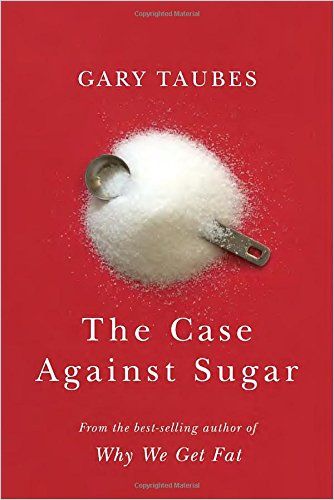Award-winning science writer Gary Taubes details the damage sugar causes and the many disinformation campaigns that strive to keep Americans from consuming less sugar.

Eat Less Sugar
Award-winning science writer Gary Taubes unpacks the complex history of sugar as a cultural force and nutrient. He tells of doctors and nutritionists – whom the sugar industry funds – who maintain that dietary fat – not sugar – causes the so-called Western diseases of obesity, diabetes, heart disease and hypertension. If you worry about whether to limit fat or sugar intake, Taubes offers clarity.
Renowned bestseller Michael Pollan said of Taubes, “I can’t think of another journalist who has had quite as profound an influence on the conversation about nutrition.” The New York Times called Taubes’s writing, “…both inflammatory and copiously researched. It is also well timed… Hard-charging (and I’ll add game-changing).” The Atlantic said, “Taubes builds his case through lawyerly layering of rich detail… Extraordinary and refreshing.”
Diabetes
Taubes reports that in the sixth century BC, a Hindu physician first noted diabetes mellitus. If left untreated, the author warns, diabetes leads to emaciation, unquenchable thirst, attendant urination and speedy death.
Taubes notes that 2012, the Centers for Disease Control (CDC) estimated one in seven or eight American adults had diabetes, which leads to higher rates of death from heart disease, stroke, kidney disease and diabetic coma. Taubes shows that tobacco companies use sugar to enhance the “inhalability” that makes cigarettes so addictive. Treatment, the author explains, retards diabetes’ nerve damage, tooth decay, skin ulcers and deteriorating eyesight; treating diabetes is a $30 billion-a-year industry in the United States.
Diabetes has surged 800% since 1960, coinciding, Taubes makes plain, with an increase in sugar consumption. The US Food and Drug Administration (FDA) calls the sugars in question “caloric sweeteners,” which, Taubes clarifies, derive from sucrose in beets or sugarcane and high-fructose corn syrup (HFCS) derived from corn.
The taste of sugar will soothe distress, and thus ‘distress vocalizations,’ in infants; consuming sugar will allow adults to work through pain and exhaustion and to assuage hunger pains.Gary Taubes
Food industries created candy and chocolate bars in the mid-19th century, the author breaks down, followed by ice cream and soft drinks at the turn of the 20th century. Taubes tells how refrigerators and vending machines brought ice cream into homes and Coca-Cola to work and how breakfast cereals went from sugar-free Grape Nuts and Corn Flakes to Sugar Corn Pops and Sugar Frosted Flakes.
As populations Westernize, Taubes points out that people eat more fats and proteins and fewer carbohydrates. Incidences of obesity, heart disease, cancer and diabetes rose among the Inuit, Maasai and South Pacific Islanders, Taubes’s research reveals, even though they ate less fat as they transitioned to a Western diet. Taubes paints conventional medical thought as believing obesity stems from people eating more calories than they expend in exercise, thus creating an energy imbalance.
Insulin and Diabetes
Taubes runs down the basics: The pancreas releases insulin when blood sugar rises, signaling muscles to burn up excess glucose and telling fat cells to hold onto fat. When insulin levels lower, cells release fat as fuel.
Both type 2 diabetics and the obese…tended to have elevated levels of blood sugar and abnormally high levels of insulin circulating in their bloodstream.Gary Taubes
Taubes describes type 2 diabetes as a disease of insulin resistance; patients’ bodies don’t lower blood sugar levels when insulin secretes and insulin drives obesity by triggering the body to hold onto fat. Taubes tracks how this hypothesis ushered in carbohydrate-restricted diets in the mid-1960s. He shows pundits whom the sugar industry sponsored denounced the diets, promoting the mantra “a calorie is a calorie.” Shockingly, Taubes cites 2015 New York Times reporting that Coca-Cola–funded research still pushes that argument.
Publicly, the sugar industry would address the threat by looking for ways to diversify their products – continuing to fund research on the use of sugar in paints, detergents, water purification and cigarettes.Gary Taubes
He calls out the sugar industry’s trade organization – the nonprofit Sugar Association Inc. – for offering assertions about sugar that aligns with sugar industry preferences and arguing sugar does not cause tooth decay and obesity.
Refined sugars, Taubes demonstrates, digest more rapidly, overwhelming the pancreas.
There is a pattern of metabolic and maybe hormonal disturbances, a whole cluster of them, that cause heart disease – or at least accompany it.Gary Taubes
The author shows how, in 1977, the FDA declared sugar consumption safe at current levels of consumption – about 42 pounds [about 19 kilos] of sugar per person yearly. But, Taubes bemoans, at the beginning of the 21st century, the US Department of Agriculture estimated that Americans consumed 90 pounds annually.
Because sugar is half fructose and never leaves the liver, Taubes explains that it has a relatively low glycemic number, indicating low stress on the pancreas. Thus, he reports, the American Diabetes Association claimed sugar and fructose safe for diabetics. Americans consumed more sugar and more HFCS as obesity and diabetes rates continued to rise.
When populations underwent Westernization, chronic diseases emerged with it, whether rapid or not, and typically in the same order, beginning with periodontal disease.Gary Taubes
Eventually, Taubes clarifies, medical researchers focused on insulin resistance and metabolic syndrome as harbingers of heart disease, diabetes, obesity, hypertension, inflammation, cancer, and other diseases.
If it’s sugar that causes insulin resistance, it’s hard to avoid the conclusion that sugar causes cancer, radical as this may seem.Gary Taubes
Science must, Taubes insists, investigate the sugar connection to disease and delineate guidelines to determine when consuming sugar passes from safe to risky.
Review
Taubes is a man on a mission and his missionary zeal can cause him to be repetitive regarding the bias against sugar causing disease despite overwhelming evidence to the contrary. His outrage at the industry lies that murder Americans is plain, and he backs that outrage with copious – and at times overwhelming – evidence of the grim truth surrounding sugar consumption. His emphasizes three processes: the physical, the political/economic and the medical, all of which swirl around one another in a swamp of contradictions and obfuscation. Thankfully, Taubes is a remarkably clear, straightforward writer who lays out his evidence so anyone can understand it. Those employed by the sugar industry will revile this work; everyone else may regard it as a life-saving revelation.
Taubes’s books include the best-selling Why We Get Fat and Good Calories, Bad Calories. Other words on the toxicity of sugar include Fat Chance by Robert H. Lustig; Pure, White and Deadly by John Yudkin; and Suicide By Sugar by Nancy Appleton.





